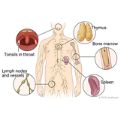Test Overview
The serum protein electrophoresis (SPEP) test measures specific proteins in the blood to help identify some diseases. Proteins are substances made up of smaller building blocks called amino acids. Proteins carry a positive or a negative electrical charge, and they move in fluid when placed in an electrical field. Serum protein electrophoresis uses an electrical field to separate the proteins in the blood serum into groups of similar size, shape, and charge.
Blood serum contains two major protein groups: albumin and globulin. Both albumin and globulin carry substances through the bloodstream. Using protein electrophoresis, these two groups can be separated into five smaller groups (fractions):
- Albumin. Albumin proteins keep the blood from leaking out of blood vessels. Albumin also helps carry some medicines and other substances through the blood and is important for tissue growth and healing. More than half of the protein in blood serum is albumin.
- Alpha-1 globulin. High-density lipoprotein (HDL), the "good" type of cholesterol, is included in this fraction.
- Alpha-2 globulin. A protein called haptoglobin, which binds with hemoglobin, is included in the alpha-2 globulin fraction.
- Beta globulin. Beta globulin proteins help carry substances, such as iron, through the bloodstream and help fight infection.
- Gamma globulin. These proteins are also called antibodies. They help prevent and fight infection. Gamma globulins bind to foreign substances, such as bacteria or viruses, causing them to be destroyed by the immune system.
Each of these five protein groups moves at a different rate in an electrical field and together form a specific pattern. This pattern helps identify some diseases.
Why It Is Done
Serum protein electrophoresis is most often done to help diagnose and monitor a wide variety of conditions. These include:
- Some forms of cancer.
- Problems with the kidneys or liver.
- Problems with the immune system.
- Conditions that lead to poor nutrition.
How To Prepare
In general, there's nothing you have to do before this test, unless your doctor tells you to.
How It Is Done
A health professional uses a needle to take a blood sample, usually from the arm.
How It Feels
When a blood sample is taken, you may feel nothing at all from the needle. Or you might feel a quick sting or pinch.
Risks
There is very little chance of having a problem from this test. When a blood sample is taken, a small bruise may form at the site.
Results
Test results for each protein group are given as a percentage of the total amount of serum protein. To obtain the actual amount of each fraction, a test that measures the total serum protein must also be done.
Results are usually ready in 2 to 3 days.
Normal
Each lab has a different range for what's normal. Your lab report should show the range that your lab uses for each test. The normal range is just a guide. Your doctor will also look at your results based on your age, health, and other factors. A value that isn't in the normal range may still be normal for you.
High values
High values may be caused by many conditions. Some of the most common are shown here.
- High albumin: Dehydration
- High alpha-1 globulin: Infection; inflammation
- High alpha-2 globulin: Inflammation; kidney disease
- High beta globulin: Very high cholesterol; low iron (iron-deficiency anemia)
- High gamma globulin: Inflammation; infection; liver disease; some forms of cancer
Low values
Low values may be caused by many conditions. Some of the most common are shown here.
- Low albumin: Poor nutrition; inflammation; liver disease; kidney disease
- Low alpha-1 globulin: Severe inflammation; liver disease
- Low alpha-2 globulin: Thyroid problems; liver disease
- Low beta globulin: Poor nutrition
- Low gamma globulin: Problems with the immune system
Related Information
Credits
Current as of: September 8, 2022
Author: Healthwise Staff
Medical Review:
Anne C. Poinier MD - Internal Medicine
Martin J. Gabica MD - Family Medicine
E. Gregory Thompson MD - Internal Medicine
Kathleen Romito MD - Family Medicine
Adam Husney MD - Family Medicine
Current as of: September 8, 2022
Author: Healthwise Staff
Medical Review:Anne C. Poinier MD - Internal Medicine & Martin J. Gabica MD - Family Medicine & E. Gregory Thompson MD - Internal Medicine & Kathleen Romito MD - Family Medicine & Adam Husney MD - Family Medicine


